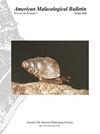伊利湖上的淡水贻贝组合
IF 0.4
4区 生物学
Q4 MARINE & FRESHWATER BIOLOGY
引用次数: 6
摘要
摘要:当一条溪流进入一个大湖时,河口代表了一个过渡环境,它在本质上既不是真正的乳液也不是扁豆,因此很可能会影响现有的动物群。关于栖息地面积和河流大小的理论预测,随着流域大小的增加,物种丰富度将在下游进一步增加,但随着河流坡度和流速的下降,河口呈现出一种不同的、研究不足的栖息地。Unionidae科的淡水贻贝数量正在减少,因此了解它们在不同栖息地的反应也至关重要。从2010年到2012年,我们在伊利湖西部和中部流域的12条小支流和两个大河口的下游对贻贝群落进行了采样,流域面积从10到4000平方公里不等。通过遥感对这些流域的土地利用进行了评估,并通过标准协议对其基本水化学及其海底生物组成进行了评估。所有流域都有本地统一贻贝的证据,发现有14种活的贻贝,占整个伊利湖贻贝物种的75%。物种-面积关系发生了,尽管这种影响比该地区流动溪流的影响要弱。此外,栖息地和相应的组合具有沉积性质,在逻辑上遵循高农业土地利用率和相应的高浊度水平以及淤泥和粘土的比例。因此,湖泊环境影响了贻贝的组合,但这些条件似乎限制了河口的dreissenid贻贝。本文章由计算机程序翻译,如有差异,请以英文原文为准。
Freshwater Mussel Assemblages at the Lotic-Lentic Interface along Lake Erie
Abstract:
Where a stream enters a large lake, the mouth represents a transitional environment that is neither truly lotic nor lentic in nature and therefore is likely to affect the fauna present. Theory on habitat area and stream size predicts that species richness will increase farther downstream as watershed size increases, but as stream gradient and thus flow rate declines, stream mouths present a different and understudied habitat. Freshwater mussels in the family Unionidae are in decline, and therefore understanding how they respond across diverse habitats is also critical. We sampled mussel assemblages from 2010 to 2012 in the lower reaches of twelve small tributaries and two large embayments of the western and central basins of Lake Erie, where watershed size ranged from 10 to 4000 km2. These watersheds were assessed for land use by remote sensing and for basic water chemistry and the composition of their benthos by standard protocols. Evidence of native unionid mussels occurred in all watersheds, with 14 species found alive, which make up 75% of mussel species still present throughout Lake Erie. A species-area relationship occurred, although the effect was weaker than that present for flowing streams in the region. Additionally, the habitat and corresponding assemblages were characterized as depositional in nature, which logically follow high agricultural land use and corresponding high levels of turbidity and the proportion of silt and clay. Therefore, the lake environment influenced mussel assemblages, yet these conditions appear to limit dreissenid mussels in river mouths.
求助全文
通过发布文献求助,成功后即可免费获取论文全文。
去求助
来源期刊
CiteScore
1.00
自引率
40.00%
发文量
1
审稿时长
>12 weeks
期刊介绍:
The American Malacological Bulletin serves as an outlet for reporting notable contributions in malacological research. Manuscripts concerning any aspect of original, unpublished research,important short reports, and detailed reviews dealing with molluscs will be considered for publication. Recent issues have included AMS symposia, independent papers, research notes,and book reviews. All published research articles in this journal have undergone rigorous peer review, based on initial editor screening and anonymous reviewing by independent expertreferees. AMS symposium papers have undergone peer review by symposium organizer, symposium participants, and independent referees.

 求助内容:
求助内容: 应助结果提醒方式:
应助结果提醒方式:


